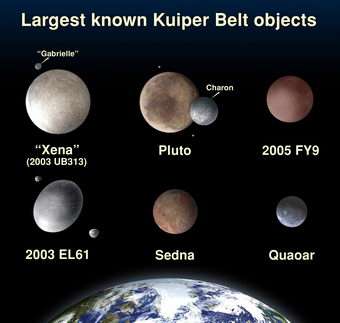Hubble Finds the 'Tenth Planet' is Slightly Larger than Pluto

NASA's Hubble Space Telescope has resolved the "tenth planet," nicknamed "Xena," for the first time and has found that it is only just a little larger than Pluto.
Though previous ground-based observations suggested that Xena was about 30 percent greater in diameter than Pluto, Hubble observations taken on Dec. 9 and 10, 2005, yield a diameter of 1,490 miles (with an uncertainty of 60 miles) for Xena. Pluto's diameter, as measured by Hubble, is 1,422 miles.
"Hubble is the only telescope capable of getting a clean visible-light measurement of the actual diameter of Xena," said Mike Brown, planetary scientist at the California Institute of Technology in Pasadena, Calif. Brown's research team discovered Xena, and their results have been accepted for publication in the Astrophysical Journal.
It only required a couple of Hubble images to nail Xena's diameter. Located 10 billion miles away, but with a diameter that is a little more than half the width of the United States, the object is 1.5 picture elements across in Hubble's view. That's enough to precisely make a size measurement.
Because Xena is smaller than earlier thought, but comparatively bright, it must be one of the most reflective objects in the solar system. The only object more reflective is Enceladus, a geologically active moon of Saturn whose surface is continuously recoated with highly reflective ice by active geysers.
Xena's bright reflectivity is possibly due to fresh methane frost overlying the surface. It is possible that Xena had an atmosphere when it was closer to the Sun, but "froze out" at its current large distance, and material settled on its surface as frost.
Another possibility is that Xena is also continuously leaking methane gas from its warmer interior. When this methane makes it to the cold surface it immediately freezes solid, covering craters and other features to make this Kuiper Belt object (KBO) uniformly bright to Hubble's telescopic eye.
Xena is officially catalogued as 2003 UB313. Its orbital period is about 560 years, and the KBO is now very close to aphelion (the point on its orbit that is farthest from the Sun).
Brown next plans to use Hubble and other telescopes to study other recently discovered KBOs that are almost as large as Pluto and Xena. The Kuiper Belt is a vast ring of primordial icy comets and larger bodies encircling Neptune's orbit.
Finding that the largest known KBO is a virtual twin to Pluto may only further complicate the debate about whether to categorize the large icy worlds that dwell in the Kuiper Belt as planets. If Pluto were considered to be the minimum size for a planet, then Xena would fulfill this criterion, too.
Source: Space Telescope Science Institute (STScI)















